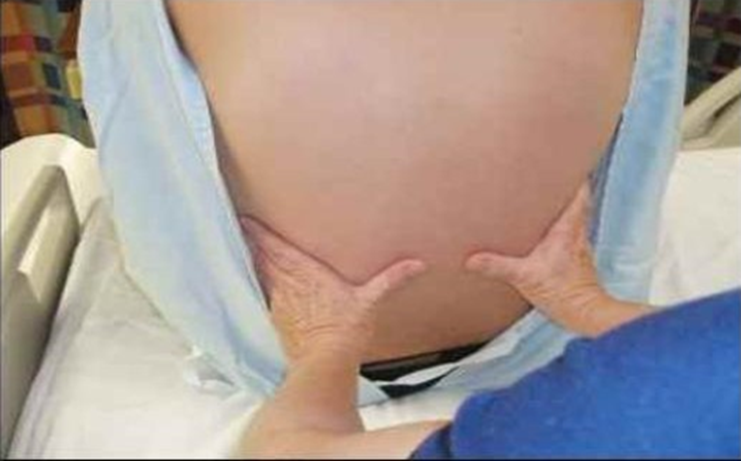The nurse continues the respiratory assessment of a client's chest excursion by placing both hands as seen in the picture. Which instruction should the nurse give the client?

Hold your breath.
Take a deep breath
Cough vigorously
Lean forward.
The Correct Answer is B
A. Hold your breath: Holding the breath would prevent the nurse from observing chest movement during inhalation and exhalation, making it unsuitable for assessing chest excursion.
B. Chest excursion is assessed to evaluate the symmetry and depth of lung expansion. By instructing the client to take a deep breath, the nurse can observe the movement of both hands as the lungs expand. Symmetrical and adequate movement indicates normal lung function, while asymmetry may suggest conditions such as pneumothorax, pleural effusion, or atelectasis.
C. Cough vigorously: While coughing may be helpful in evaluating airway clearance or adventitious sounds, it is unrelated to chest excursion.
D. Lean forward: Leaning forward is not necessary for chest excursion assessment; this position is typically used for auscultating posterior lung sounds or relieving dyspnea in conditions like COPD.
Nursing Test Bank
Naxlex Comprehensive Predictor Exams
Related Questions
Correct Answer is D
Explanation
A. Review recent serum bilirubin levels: This is an indirect confirmation but not part of a physical assessment.
B. Assess conjunctival sacs of lower lids for pallor: This checks for anemia, not jaundice.
C. Observe the client's urine for dark orange color: This may suggest jaundice but is not definitive or diagnostic.
D. Examine the client's sclera for icterus: Scleral icterus is the most reliable physical sign of jaundice and directly reflects elevated bilirubin levels.
Correct Answer is C
Explanation
A. A score indicating an increased risk for falling does not necessarily indicate the need for a walker unless mobility is severely impaired.
B. Parkinson's disease may cause gait and balance issues but cannot be definitively diagnosed from a Tinetti score alone.
C. A Tinetti balance score of 12 and a gait score of 8 suggest that the client has significant balance and gait impairment, which places them at increased risk for falls.
D. These scores are not expected results for an older adult, as they indicate a higher risk for falls.
Whether you are a student looking to ace your exams or a practicing nurse seeking to enhance your expertise , our nursing education contents will empower you with the confidence and competence to make a difference in the lives of patients and become a respected leader in the healthcare field.
Visit Naxlex, invest in your future and unlock endless possibilities with our unparalleled nursing education contents today
Report Wrong Answer on the Current Question
Do you disagree with the answer? If yes, what is your expected answer? Explain.
Kindly be descriptive with the issue you are facing.
